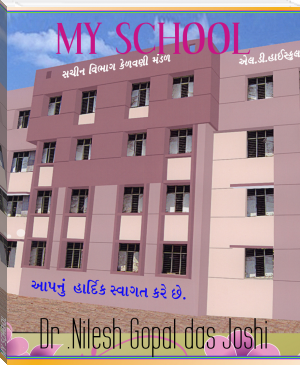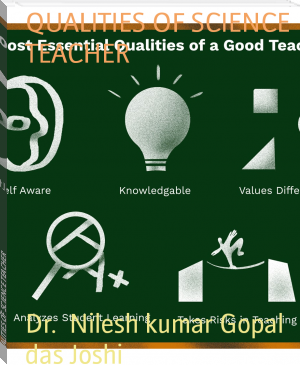MY SCHOOL by Dr .Nilesh Gopal das Joshi (beginner reading books for adults .txt) 📕

- Author: Dr .Nilesh Gopal das Joshi
Book online «MY SCHOOL by Dr .Nilesh Gopal das Joshi (beginner reading books for adults .txt) 📕». Author Dr .Nilesh Gopal das Joshi
POSTURES- Part II
Correct Postures in Various Situations
Good and correct postures can be described as:
Sitting Posture:In correct sitting posture, various organs of the body and the body as a whole are balanced; the legs may be crossed; the hips are properly and comfortably placed at the seat; the head, shoulder and the hips are in a straight vertical line; and the vertebral column is perfectly vertical.
Standing Posture:In correct standing posture, the body weight should equally fall on both the legs; the whole body should be vertical and erect; the heels should rest evenly on the flat floor; the two arms should rest on the thighs in a straight line; the head and the body should not bend forward; the body should not bend on one of its sides; and the body as a whole should be balanced.
Reading Posture:While reading, the book should not be placed very close to the eyes, it should be at least 12 inches away; and the hand holding the book should form an angle of 45 degrees with the eyes.
Writing Posture:While writing, the position of the table or desk should be very close to the body; the body should be in an upright position and not bent over the book; the legs should rest on the ground; the book should be at a distance of 12 inches from the eyes; the paper should be placed parallel to the edge of the desk, and the pen should be held in between the thumb and two fingers.
Walking Posture:While walking, the body as a whole should be erect and upright; the eyes should look straight at an angle of 90 degrees; the arms should swing alternately along with steps preferably up to an angle of 90 degrees with the body; the heels should touch the ground first and then the middle portion and the toes; and one should take steps of normal dimension.
General Remedial Measures for Proper Postures
The students should be asked to take regular exercise to strengthen muscles. Suitable furniture should be provided. Good postural habits should be developed. Stools should be provided for smaller children so that they may sit without reclining against the chair. Suitable corrective postural exercises should be recommended to the students. Students having defective eye-sight and hearing should be seated on the front benches. Rooms should be suitably ventilated. Bold type books should be selected. Help of school medical officer should be sought. Time table should be so arranged that students do not feel the impact of fatigue. Cause of students’ tension should be removed. Sufficient sitting space should be provided to the students. Nutritious and balanced mid-day meals should be provided to students. Proper arrangement for sufficient light should be made in the classroom. Teachers should check wrong postures of the students. Small children should not be engaged too much in drill.COMMON POSTURAL DEFECTS
For want of knowledge in correct postural habit of standing, sitting and reading, students adopt faulty postures. As a result, their backbone bends, the chest becomes like a pigeon chest, the shoulders turn drooping, feet becomes flat, vision turns defective and many other deformities appear in the body.
The faulty postural habits of the students develop due to home and school conditions. Let us discuss them in detail.
Home Conditions
When the home conditions become poor, children do not get proper nourishing and balanced diet. As a result, the bones and muscles of such children get weak. They feel tired within a short period of time. Wrong postural habits among the children develop for want of fresh air, sufficient light, rest and sleep. Wrong postural habits are also caused due to the type of dress children use in modern times. Many children adopt faulty postures as a fashion and convert their natural postures to artificial ones. For want of proper physical exercises and practice of developing dirty habits children develop faulty postural habits.School Conditions
Most of the schools provide desks and chairs with uniform size and shape. As a result students having different physical standards fail to sit comfortably. Thus, wrong postural habit of reading and writing develops among the students. For want of proper supervision in schools in respect of fatigue and recreation, students develop in them faulty habits. Most of us overlook the faulty postural habits of the students, and they develop these habits. Usually students carry their school bags on their shoulders. This habit influences posture. Some postural defects arise when the students are continuously engaged in some work and tire their brain. Therefore, they like to change their body position simply to be relaxed.Sometimes, we teachers are at fault. A teacher whose writing on the board is illegible causes children to adjust themselves. Similarly, a teacher who has developed wrong postures, sets an example for children to copy and imitate them.
Common postural deformities
Postural deformities imply not having proper alignment of body parts. They are exaggerated curvatures of spine. An individual who has postural deformities cannot perform his work efficiently. It is of utmost importance that various deformities are detected at an early age, and proper steps taken at right time to prevent the deformity. Some of the common deformities are,
Round shoulders – Round shoulders are the result of poor postures in work, faulty furniture and wrong habits of sitting and standing. It is associated with forward displacement of the shoulders.Causes - by wearing very tight clothes, sitting on improper furniture, lack of proper exercise especially of shoulders
Hollow back or Lordosis - It is a more severe degree of round shoulders and an exaggerated forward curve in the lumbar region producing a stoop in the upper part of the body, prominent abdomen and a slouching gait.Lordosis causes the back to bend in either direction. Curvature also appears in the waist region. The shoulder bones in the back also seem to be bending towards the sides. Hips also protrude out. When an individual suffers from lordosis, they experience pain in their back and works like a lame person.
Causes – causes for lordosis may be an early symptom for tuberculosis of the spine or hip disease or malnutrition with poor muscles. Persons having underdeveloped legs, diseases of bone joints, dislocation of hips or infantile paralysis exhibit lordosis. Even faulty standing posture results in this disease. Those who have the habit of standing on one leg suffer from this disease.
To get rid of this problem, a child should be made to stand in the correct posture. There must be provision for special exercises to cure this disease. Attempts must be made to provide proper treatment on the advice of the physician.
Kyphosis or round upper back –It is the exaggeration of the normal dorsal backward curve of the spine resulting slouching attitude, flat or depressed chest, protruding abdomen and drooped head.Causes – causes for kyphosis are weak muscles, long illness, malnutrition, deficient ventilation, over-crowded places, weak eyesight, and wrong furniture. Rickets also cause kyphosis.
Scoliosis or lateral curvature of the spine – This generally shows curvature to the left side. The spine forms a long curve. The chest is prominent on the left side while the back is prominent on the right side due to rotation of the spine in the thoracic region. The right hip is or prominent than the left due to a displacement of the trunk to the left side.Scoliosis is of two types
Structural Scoliosis: Structural scoliosis is lateral spinal deviation due to rickets, osteomalacia and polio. Functional Scoliosis: Functional scoliosis is caused by poor walking, standing or sitting posture. There is a c-shaped lateral side curve which is generally common or s-shaped combined curve with right lumbar curvature.Causes – it is due to carrying heavy load on shoulder. Unhealthy alcohol conditions like inadequate lightning arrangements, unsuitable desks, partial deafness or wrong standing postures, are also its causes.
Treatment
Scoliosis is generally a structural deformity and it should be treated only by an orthopaedic surgeon.
Exercises are of no use unless they are functional and the person tries to correct himself habitually. The teacher should help the children to change their poor habit patterns of postures. Besides corrective exercises, relaxation, development of correct habit pattern and well balanced diet should not be ignored.
Flat back – It refers to a spine which has no dorsal and lumbar curves. It predisposes towards a flat chest, drooping shoulders and loss of flexibility. Flat foot – In a normal foot there are two curves or arches one longitudinal and the other transverse, in between the big toe and the little toe and the body weight is borne by the heel and outer side of the foot and the ball of the big toe. In flat foot both the arches are missing. The foot muscles and ligaments supporting the bony arch become weak and the arch flattens down.Causes – putting on heavy shoes, long standing position without rest, jumping on harder surface also sometimes result in breaking or loosening of the ligaments of the bony arch or injury and overweight, may also be some of its causes.
Treatment
Special shoes- such as raising the inner side of the soles and heels, to throw body weight on to the other side of the feet will help. Remedial exercises to strengthen the muscles, which keep up the arch, will help. Walking on outer sides of the feet is good. Long standings should be avoided. In case of pain in feet, give complete rest. Knock-knee – In knock-knee when the child stands, the knees join together and the feet parallel. There is a big gap between the ankles varying directly with the degree of deformity.Causes: Rickets, deficiency of vitamin D and calcium in the diet, prolonged standing, flat foot, obesity, heavy body weight and some long illnesses can cause it.
Treatment:
Use of cod-liver oil in the diet will help in removing the deficiency of vitamin D. Treatment for flat foot should be given. Avoid prolonged standings. Horse riding is the best exercise. Wearing of walking irons will help. Massage by physiotherapist will also help.Remedial Measures
In order to correct the defective postures of the students, we must first ensure a balanced diet for them. They may be asked to take regular exercise to strengthen their muscles and bones. Fresh air, rest and sleep should also be ensured. Overwork should be avoided and excessive fatigue should not be allowed to happen. Good postural habits should be inculcated in them by paying proper attention to them while they are sitting, standing, walking, reading or writing. Their vision and hearing should be examined and students with defective eyesight and hearing should be seated in the front row.
Along with mass drill, march past and yogasanas, suitable corrective exercises should be recommended for the needed children. There should be suitable uniform or dress for all. Books used should be of bold type and classrooms should be spacious and well ventilated. Stools should be provided for smaller children so that they may learn to sit without reclining against the back of the chair. The suitability of furniture should be ensured.
Suggested Physical Exercises for Improving Postural Defects
There are numerous exercises for improving postural defects. The problem is that of appropriate selection. At the slightest sign of pain, inflammation, swelling or unusual fatigue, the exercises should be discontinued until the causes have been determined and medical advice obtained, for continuing or changing the exercises.
Some exercises are suggested by A.S. Daniels and E.A. Davies for improving certain postural deformities:
For improving the head and neck




Comments (0)